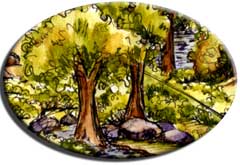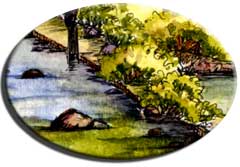Why are riparian cover and buffer important?
The characteristics of the area immediately surrounding a stream can affect channel form, sediment input, pollution, water temperatures, and the type of life a stream can support. These areas bordering a stream are known as “riparian areas.” Streams that flow through highly developed or urban areas often lack a functional streamside corridor to protect the stream from human influences like trash, contaminants, and even foot traffic, causing the stream to become unhealthy.
Naturally, California streams support a broad range of riparian habitat types. Some healthy streams are surrounded by bare ground or steep canyons, while others support grasses, shrubs, trees, or even wetlands. Healthy riparian areas can help absorb flood flows and provide a protective buffer between the stream and the surrounding land uses, as well as providing important habitat for wide range of species. Streamside vegetation also provides shade that can help keep water temperature low enough for species such as salmon to survive, and filters contaminants entering streams. Contiguous riparian areas can also provide corridors for the migration of wildlife.
How do we measure the condition of riparian areas?
To assess streamside characteristics and riparian health, investigators can record the type of vegetation found along a stream, the width of the riparian zone, and other factors.

riparian cover

buffer

